What’s Up For September 2016
What’s Up for September 2016

We won’t have a solar eclipse until Aug. 21, 2017, but observers in central Africa will see an annular eclipse, where the moon covers most but not all of the sun, on Sept. 1. Observers always need to use safe solar eclipse glasses or filters on telescopes, binoculars and cameras.

Also this month, there are two minor meteor showers, both with about 5 swift and bright meteors per hour at their peak, which will be near dawn. The first is the Aurigid shower on Sept. 1. The new moon on the first means the sky will be nice and dark for the Aurigids.

The second shower is the Epsilon Perseids on Sept. 9. The first quarter moon sets on the 9th at midnight, just in time for the best viewing of the Perseids.

There are many nice pair-ups between the moon and planets this month. You can see the moon between Venus and Jupiter on Sept. 2, and above Venus on the 3rd, right after sunset low on the West-Southwest horizon. On the 15th the nearly full moon pairs up with Neptune, two weeks after its opposition, when the 8th planet is closest to Earth in its orbit around the sun.
Watch the full September “What’s Up” video for more:
Make sure to follow us on Tumblr for your regular dose of space: http://nasa.tumblr.com.
More Posts from Nasa and Others
5 Facts About Earth's Radiation Donuts 🍩
Did you know that our planet is surrounded by giant, donut-shaped clouds of radiation?

Here's what you need to know.
1. The radiation belts are a side effect of Earth's magnetic field

The Van Allen radiation belts exist because fast-moving charged particles get trapped inside Earth's natural magnetic field, forming two concentric donut-shaped clouds of radiation. Other planets with global magnetic fields, like Jupiter, also have radiation belts.
2. The radiation belts were one of our first Space Age discoveries

Earth's radiation belts were first identified in 1958 by Explorer 1, the first U.S. satellite. The inner belt, composed predominantly of protons, and the outer belt, mostly electrons, would come to be named the Van Allen Belts, after James Van Allen, the scientist who led the charge designing the instruments and studying the radiation data from Explorer 1.
3. The Van Allen Probes have spent six years exploring the radiation belts

In 2012, we launched the twin Van Allen Probes to study the radiation belts. Over the past six years, these spacecraft have orbited in and out of the belts, providing brand-new data about how the radiation belts shift and change in response to solar activity and other factors.
4. Surprise! Sometimes there are three radiation belts

Shortly after launch, the Van Allen Probes detected a previously-unknown third radiation belt, created by a bout of strong solar activity. All the extra energy directed towards Earth meant that some particles trapped in our planet's magnetic field were swept out into the usually relatively empty region between the two Van Allen Belts, creating an additional radiation belt.
5. Swan song for the Van Allen Probes

Originally designed for a two-year mission, the Van Allen Probes have spent more than six years collecting data in the harsh radiation environment of the Van Allen Belts. In spring 2019, we're changing their orbit to bring the perigee — the part of the orbit where the spacecraft are closest to Earth — about 190 miles lower. This ensures that the spacecraft will eventually burn up in Earth's atmosphere, instead of orbiting forever and becoming space junk.
Because the Van Allen Probes have proven to be so hardy, they'll continue collecting data throughout the final months of the mission until they run out of fuel. As they skim through the outer reaches of Earth's atmosphere, scientists and engineers will also learn more about how atmospheric oxygen can degrade satellite measurements — information that can help build better satellites in the future.
Keep up with the latest on the mission on Twitter, Facebook or nasa.gov/vanallenprobes.
Human Expansion Across Solar System
On this day in 1972, two NASA astronauts landed on the Moon. Now, 45 years later, we have been instructed to return to the lunar surface.
Today at the White House, President Trump signed the Space Policy Directive 1, a change in national space policy that provides for a U.S.-led program with private sector partners for a human return to the Moon, followed by missions to Mars and beyond.

Among other dignitaries on hand for the signing, were NASA astronauts Sen. Harrison “Jack” Schmitt, Buzz Aldrin, Peggy Whitson and Christina Koch.
Schmitt landed on the moon 45 years to the minute that the policy directive was signed as part of our Apollo 17 mission, and is the most recent living person to have set foot on our lunar neighbor.

Above, at the signing ceremony instructing us to send humans back to the lunar surface, Schmitt shows First Daughter Ivanka Trump the Moon sample he collected in 1972.
The effort signed today will more effectively organize government, private industry and international efforts toward returning humans on the Moon, and will lay the foundation that will eventually enable human exploration of Mars.
To learn more, visit: https://www.nasa.gov/press-release/new-space-policy-directive-calls-for-human-expansion-across-solar-system
Make sure to follow us on Tumblr for your regular dose of space: http://nasa.tumblr.com.
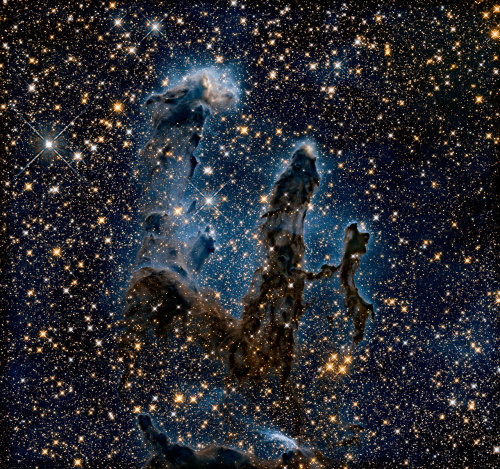
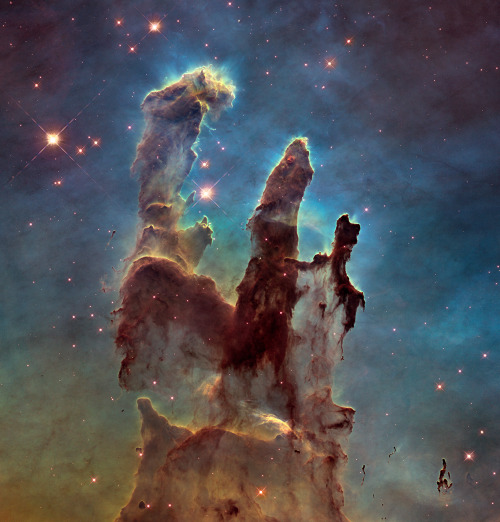
Sometimes... there’s more than meets the eye. 👀 You’re looking at two very different takes on an iconic image.
Human eyes can see only a small portion of the range of radiation given off by the objects around us. We call this wide array of radiation the electromagnetic spectrum, and the part we can see visible light.
In the first image, researchers revisited one of Hubble Space Telescope’s most popular sights: the Eagle Nebula’s Pillars of Creation. Here, the pillars are seen in infrared light, which pierces through obscuring dust and gas and unveil a more unfamiliar — but just as amazing — view of the pillars. The entire frame is peppered with bright stars and baby stars are revealed being formed within the pillars themselves. The image on the bottom is the pillars in visible light.
Image Credit: NASA, ESA/Hubble and the Hubble Heritage Team
Make sure to follow us on Tumblr for your regular dose of space: http://nasa.tumblr.com.
InSight Mission to Mars

Our InSight mission will place a fixed science outpost on Mars to study its deep interior. Findings and research from this project will address one of the most fundamental questions we have about planetary and solar system science – How in the world did these rocky planets form?
By investigating the interior structure and processes of Mars, the InSight mission will gain a better understanding of the evolutionary formation of planets, including Earth.
InSight will record Mars’ vital signs to learn more about the planet, including:

Seismic Activity:
A seismometer will be used to record the seismic activity on Mars. This will give us information on the crust, mantel and core; and the relationship between them.

Temperature:
A heat flow probe will be used to take Mars’ temperature and determine the change over the course of a full Martian year.

Reflexes:
By looking at how the rotation of Mars wobbles, we will better understand what the core size may be and its composition.

Launch for the InSight mission is scheduled for March 2016, and even though you can’t physically travel with the lander, you can send your name to the Red Planet onboard. Make sure to submit your name before Sept. 8!
Make sure to follow us on Tumblr for your regular dose of space: http://nasa.tumblr.com
7 Facts That Will Make You Feel Very Small
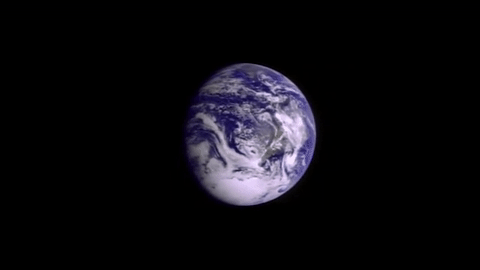
Earth, our home planet, is the fifth largest planet in our solar system and the only planet we know of where life exists. Even though Earth seems extremely large to us, it is actually a tiny spec in the vast expanse of the universe. Here are 7 space facts that will make you feel very small.

1. Our sun is one of at least 100 BILLION stars, just in the Milky Way. Scientists calculate that there are at least 100 billion galaxies in the observable universe, each one brimming with stars. There are more stars than grains of sand on all of Earth’s beaches combined.
In 1995, the first planet beyond our solar system was discovered. Now, thousands of planets orbiting sun-like stars have been discovered, also known as exoplanets.

2. The Milky Way is a huge city of stars, so big that even at the speed of light (which is fast!), it would take 100,000 years to travel across it.

3. Roughly 70% of the universe is made of dark energy. Dark matter makes up about 25%. The rest — everything on Earth, everything ever observed with all of our instruments, all normal matter adds up to less than 5% of the universe.

4. If the sun were as tall as a typical front door, Earth would be the size of a nickel.

5. The sun accounts for almost all of the mass in our solar system. Leaving .2% for all the planets and everything else.

6. Edwin Hubble discovered that the Universe is expanding and that at one point in time (14 billion years ago) the universe was all collected in just one point of space.

7. Four American spacecraft are headed out of our solar system to what scientists call interstellar space. Voyager 1 is the farthest out — more than 11 billion miles from our sun. It was the first manmade object to leave our solar system. Voyager 2, is speeding along at more than 39,000 mph, but will still take more than 296,000 years to pass Sirius, the brightest star in our night sky.
Feeling small yet? Here’s a tool that will show you just how tiny we are compared to everything else out there: http://imagine.gsfc.nasa.gov/features/cosmic/earth.html
Make sure to follow us on Tumblr for your regular dose of space: http://nasa.tumblr.com
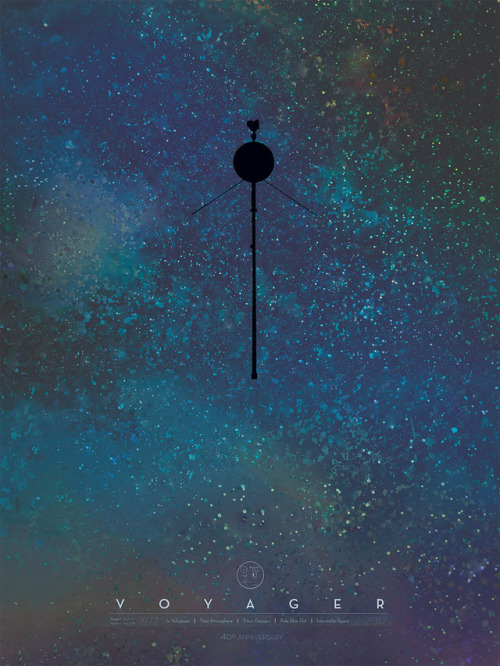
The twin Voyager spacecraft, which launched in 1977, are our ambassadors to the rest of the Milky Way, destined to continue orbiting the center of our galaxy for billions of years after they stop communicating with Earth. On Aug. 25, 2012, Voyager 1 became the first human-made object to enter interstellar space, and Voyager 2 is expected to cross over in the next few years. At age 40, the Voyagers are the farthest and longest-operating spacecraft and still have plenty more to discover. This poster captures the spirit of exploration, the vastness of space and the wonder that has fueled this ambitious journey to the outer planets and beyond.
Enjoy this and other Voyager anniversary posters. Download them for free here: https://voyager.jpl.nasa.gov/downloads/
Credit: NASA/JPL-Caltech
Make sure to follow us on Tumblr for your regular dose of space: http://nasa.tumblr.com.
Space Station Research: Observing Earth
Each month, we highlight a different research topic on the International Space Station. In April, our focus is how the space station provides a platform for studying the Earth.
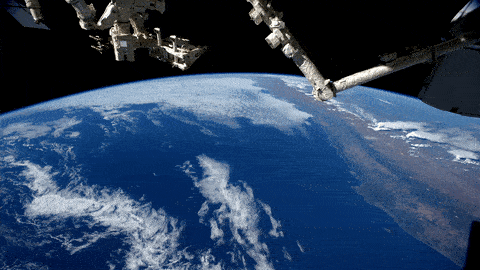
You might wonder how a laboratory 250 miles above Earth could help us study and observe our home planet, but the space station actually gives us a unique view of the blue marble we call home.
The space station is part of a fleet of Earth remote-sensing platforms to develop a scientific understanding of Earth’s systems and its response to natural or human-induced changes and to improve prediction of climate, weather and natural hazards. Unlike automated remote-sensing platforms, the space station has a human crew, a low-orbit altitude and orbital parameters that provide variable views and lighting. Crew members have the ability to collect unscheduled data of an unfolding event, like severe weather, using handheld digital cameras.

The Cupola, seen above, is one of the many ways astronauts aboard the space station are able to observe the Earth. This panoramic control tower allows crew members to view and guide operations outside the station, like the station’s robotic arm.

The space station also has an inclined, sun-asynchronous orbit, which means that it travels over 90% of the inhabited surface of the Earth, and allows for the station to pass over ground locations at different times of the day and night. This perspective is different and complimentary to other orbiting satellites.
The space station is also home to a few Earth-observing instruments, including:

The ISS-RapidScat monitors ocean winds for climate research, weather prediction and hurricane science. This vantage point gives scientists the first near-global direct observations of how ocean winds can vary over the course of the day, while adding extra eyes in the tropics and mid-latitudes to track the formation and movement of tropical cyclones.

CATS (Cloud-Aerosol Transport System) is a laser instrument that measures clouds and airborne particles such as pollution, mineral dust and smoke. Improving cloud data allows scientists to create more accurate climate models, which in turn, will improve air quality forecasts and health risk alerts.

In late 2016, we will launch Stratospheric Aerosol and Gas Experiment III (SAGE III). This experiment will measure ozone and other gases in the atmosphere to help scientists assess how the ozone layer is recovering.

Want to observe the Earth from a similar vantage point? You can thanks to our High Definition Earth-Viewing System (HDEV). This experiment is mounted on the exterior of the space station and includes several commercial HD video cameras aimed at the Earth.
Make sure to follow us on Tumblr for your regular dose of space: http://nasa.tumblr.com
Morning Jeanette. My 10 year son old recently told me his dream job that he would love to do is to become an Astronaut or be apart of a team that builds a spaceship. What is your best suggestion for me as his parent to help expose him to know what life is like for an astronaut and how much work did you put in your education to help you solidify your career that I can use as encouragement for him? Thanks again and you're AWESOME.
I spent 11 and a half years in school after high school, so I tell this to students because it takes a lot of investment in educating yourself. Then even beyond that, gaining experiences that are meaningful. After graduate school, working at Ford Motor Company and the CIA really taught me how to be a detailed scientist as well as working operationally in the field. I also did internships to help hone and sharpen skills as an engineer. I was happy with my career, and then I applied.
Solar System: Things to Know This Week
We marked the 20th anniversary of Pathfinder's landing on Mars this week.
We have had an active robotic presence there ever since—in fact, no one under 20 has experienced a day without NASA at Mars—but the Pathfinder mission was the first-ever robotic rover to explore the Red Planet. Below are 10 things to know about this iconic mission as we celebrate two decades of unprecedented science and discovery.
1. A Date to Remember
Pathfinder launched from Cape Canaveral, Florida on Dec. 4, 1996, and landed at Mars' Ares Vallis on July 4, 1997. The landing site, an ancient flood plain in Mars' northern hemisphere, is among the rockiest parts of the planet. Scientists chose it because they believed it was a relatively safe surface to land on and contained a wide variety of rocks deposited during a catastrophic flood.
2. Precious Cargo
Pathfinder delivered to Mars a tiny, 23-pound (11.5 kilogram) rover named Sojourner, which carried scientific instruments to analyze the Martian atmosphere, climate and geology. To put its small size in perspective, the mechanisms at the end of the Curiosity Rover's robotic arm are heavier than all of Sojourner. You can check out a 360 video of Pathfinder and Sojourner here.
3. Who Named the Rover?
The name Sojourner was chosen after a year-long, worldwide competition in which students up to 18 years old were invited to write about a historical heroine and how she would translate their accomplishments to the Martian environment. Twelve-year-old Valerie Ambroise of Bridgeport, Connecticut, submitted the winning essay on Sojourner Truth, a Civil War-era abolitionist who made it her mission to "travel up and down the land" advocating for the rights of all people to be free and participate fully in society.
4. Quite the Entrance
Pathfinder's landing was innovative and unprecedented. It entered the thin Martian atmosphere assisted by parachute to slow its descent and with a giant system of airbags to cushion the impact. This mission marked the first time this airbag technique was used. Spirit and Opportunity later used the same method successfully.

5. Mobile Matters
The wireless modem between Pathfinder and Sojourner was a commercial, off-the-shelf product. The project team acquired several and stress-tested them until they found the best ones to send off to Mars.
6. It's in the Details
Sojourner had bumpers—actual mechanical fenders—painted with black and white stripes. It also had two forward-facing black-and-white cameras, and one rear-facing camera (all one-third of a Megapixel). And Sojourner's tiny wheels measured just 12.5 centimeters in diameter.
7. Viral-worthy
Pathfinder was widely regarded as one of the first "internet sensations." There was so much web traffic from around the world, the entire internet backbone of France crashed under the load.
8. We're Getting Warmer
Among the many scientific discoveries from Pathfinder and Sojourner: Rounded pebbles and cobbles at the landing site suggested that Mars might have had running water during a warmer past when liquid water was stable on the planet. Early morning water ice clouds also were seen in the lower atmosphere.
9. Long Live the Mission
The lander and the rover both outlived their design lives—the lander by nearly three times, and the rover by 12 times.
10. Pathfinder's Photo Album
Go back in time and see historical photographs of Pathfinder's assembly process here.
What is the most exciting thing you hope to learn?
-
 gerten-blog1 liked this · 6 years ago
gerten-blog1 liked this · 6 years ago -
 phanmemquanlynhahang-blog1 liked this · 7 years ago
phanmemquanlynhahang-blog1 liked this · 7 years ago -
 therustyrutabaga reblogged this · 7 years ago
therustyrutabaga reblogged this · 7 years ago -
 isoelectric liked this · 7 years ago
isoelectric liked this · 7 years ago -
 astrorevival liked this · 7 years ago
astrorevival liked this · 7 years ago -
 killlerqueenxx liked this · 8 years ago
killlerqueenxx liked this · 8 years ago -
 best-hotels-posts reblogged this · 8 years ago
best-hotels-posts reblogged this · 8 years ago -
 keenturtleinfluencer-blog liked this · 8 years ago
keenturtleinfluencer-blog liked this · 8 years ago -
 shrubjade liked this · 8 years ago
shrubjade liked this · 8 years ago -
 evokerforinsomnia reblogged this · 8 years ago
evokerforinsomnia reblogged this · 8 years ago -
 evokerforinsomnia liked this · 8 years ago
evokerforinsomnia liked this · 8 years ago -
 tessalynn72-blog liked this · 8 years ago
tessalynn72-blog liked this · 8 years ago -
 ali-177-blog liked this · 8 years ago
ali-177-blog liked this · 8 years ago -
 johzyaz liked this · 8 years ago
johzyaz liked this · 8 years ago -
 carlosemiliopir liked this · 8 years ago
carlosemiliopir liked this · 8 years ago -
 darkrosemusic liked this · 8 years ago
darkrosemusic liked this · 8 years ago -
 alienfrauds liked this · 8 years ago
alienfrauds liked this · 8 years ago -
 christyoswinn7 liked this · 8 years ago
christyoswinn7 liked this · 8 years ago -
 littleplasticspaceship reblogged this · 8 years ago
littleplasticspaceship reblogged this · 8 years ago -
 thottymcgee liked this · 8 years ago
thottymcgee liked this · 8 years ago -
 jhjonesjones liked this · 8 years ago
jhjonesjones liked this · 8 years ago -
 angeltherubiks reblogged this · 8 years ago
angeltherubiks reblogged this · 8 years ago -
 analgesicsleep reblogged this · 8 years ago
analgesicsleep reblogged this · 8 years ago -
 ponvixx liked this · 8 years ago
ponvixx liked this · 8 years ago -
 nasauniversefan-blog liked this · 8 years ago
nasauniversefan-blog liked this · 8 years ago -
 bedheads reblogged this · 8 years ago
bedheads reblogged this · 8 years ago -
 what-a-daringdream-blog reblogged this · 8 years ago
what-a-daringdream-blog reblogged this · 8 years ago -
 smitten-owl liked this · 8 years ago
smitten-owl liked this · 8 years ago -
 lightning365 liked this · 8 years ago
lightning365 liked this · 8 years ago -
 paastelbee liked this · 8 years ago
paastelbee liked this · 8 years ago -
 mrchaoticftl-blog liked this · 8 years ago
mrchaoticftl-blog liked this · 8 years ago -
 sandiegobailey reblogged this · 8 years ago
sandiegobailey reblogged this · 8 years ago -
 sandiegobailey liked this · 8 years ago
sandiegobailey liked this · 8 years ago -
 silvertremblinglips liked this · 8 years ago
silvertremblinglips liked this · 8 years ago -
 nicko8732 liked this · 8 years ago
nicko8732 liked this · 8 years ago -
 surprisinglyfriendlybirds liked this · 8 years ago
surprisinglyfriendlybirds liked this · 8 years ago -
 cool-cat-felix-blog liked this · 8 years ago
cool-cat-felix-blog liked this · 8 years ago -
 curiositytherover reblogged this · 8 years ago
curiositytherover reblogged this · 8 years ago -
 sarcastic-fandomtastic-dragon liked this · 8 years ago
sarcastic-fandomtastic-dragon liked this · 8 years ago -
 thefourteenthdoctorr liked this · 8 years ago
thefourteenthdoctorr liked this · 8 years ago -
 letsdavinci liked this · 8 years ago
letsdavinci liked this · 8 years ago -
 thestarblaster-blog liked this · 8 years ago
thestarblaster-blog liked this · 8 years ago -
 thingsmydadmightlike-blog reblogged this · 8 years ago
thingsmydadmightlike-blog reblogged this · 8 years ago -
 taislydianne-blog reblogged this · 8 years ago
taislydianne-blog reblogged this · 8 years ago -
 taislydianne-blog liked this · 8 years ago
taislydianne-blog liked this · 8 years ago
Explore the universe and discover our home planet with the official NASA Tumblr account
1K posts